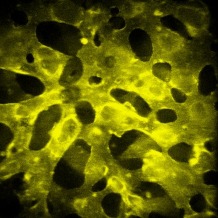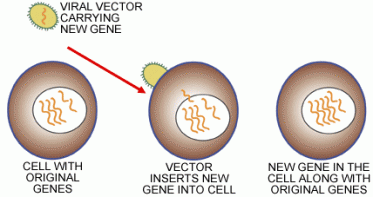Vector Method

The second method of genetic engineering is called the vector method. It may be similar to the plasmid method but its products are inserted directly into the genome via a viral vector.
The first steps are about the same. You cut the viral DNA and the DNA to be inserted with then combine the two DNA sequences, and separate out those that fuse successfully. The only major difference is that portions of the viral DNA, such as those that cause its virulence, must first be removed otherwise the organism that is to become engineered would become ill. However this does have an advantage as it allows additional space in which to insert new genes.
Once the new viral genomes have been created, they are allowed to create new protein coats and then reproduce. Then the viruses are released into a target organism. The virus then infects the target cells, inserting its genome, with the newly engineered portion into the genome of the target cell, which then begins to express and continue to replicate this new sequence and its traits with its own genetic information
Many people object to this type of genetic engineering as well because of the unpredictability of the insertion of the new DNA. It could interfere with the functions of existing genes. Also, many people are quite uncomfortable with the idea of infecting someone with a virus and hoping that it works.
It is currently being studied as a possible way to cure genetic/ hereditary diseases such as cystic fibrosis.
A simple picture of how it is done is shown below from Getenetics and Society.org
The first steps are about the same. You cut the viral DNA and the DNA to be inserted with then combine the two DNA sequences, and separate out those that fuse successfully. The only major difference is that portions of the viral DNA, such as those that cause its virulence, must first be removed otherwise the organism that is to become engineered would become ill. However this does have an advantage as it allows additional space in which to insert new genes.
Once the new viral genomes have been created, they are allowed to create new protein coats and then reproduce. Then the viruses are released into a target organism. The virus then infects the target cells, inserting its genome, with the newly engineered portion into the genome of the target cell, which then begins to express and continue to replicate this new sequence and its traits with its own genetic information
Many people object to this type of genetic engineering as well because of the unpredictability of the insertion of the new DNA. It could interfere with the functions of existing genes. Also, many people are quite uncomfortable with the idea of infecting someone with a virus and hoping that it works.
It is currently being studied as a possible way to cure genetic/ hereditary diseases such as cystic fibrosis.
A simple picture of how it is done is shown below from Getenetics and Society.org

